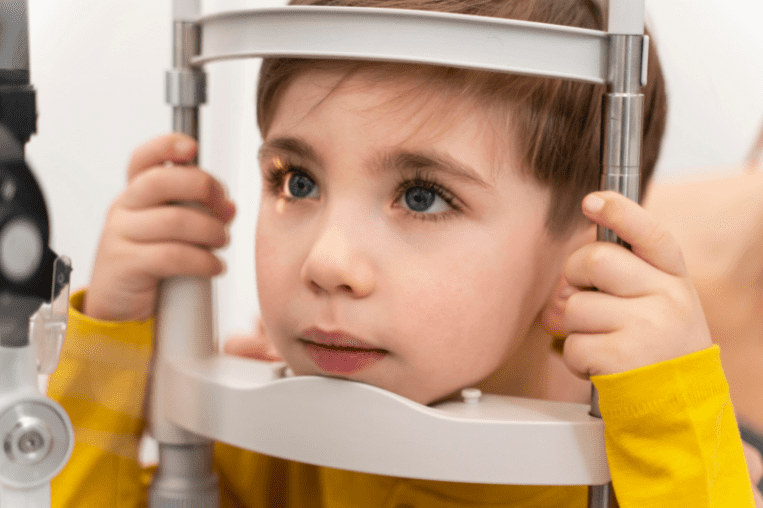Every parent wants that their child should remain fit and healthy.As the child grows, there may be some problems in their body either naturally or due to their lifestyle (habits).
Parents need to pay a lot of attention to the changes in the body and the behavior of the child, so that any problem may be identified at the very beginning.
The vision of a child develops in first 7 years of age. So, it is very important to monitor this development. Ideally every child should undergo routine eye checkup before going to school. Or if the child develops any poor sign of vision, an eye specialist must be consulted immediately to rectify the vision related problem.
Symptoms of the Child Developing any Eye Problem
As infants and growing children cannot clearly communicate their specific problems, it is therefore very essential that parents must monitor them for some silent signs of eye ailment. They should take the child for an eye checkup after observing any of the following conditions-
- Difficulty in Reading
if you receive any complain from your child’s school regarding poor writing, inability to read or difficulty in copying from the board, it is a signal that the child needs an eye checkup. if child goes near the television to watch it, it is the another important sign to consult an eye specialist.
- Sensitivity
If the child develops sensitivity to light whether inside the house or outside, that means he/she has some problem related to eyes.
- Lack of Concentration
If the child is unable to concentrate and finds it difficult to color, read or solve puzzles etc.
- Difficulty in opening the Eyelids
If the child finds it difficult to open the eyelids or if you observe any sort of swelling in the eyes, parents must consult an child eye doctor.
- Misaligned Eyes (squint)
If you find any misalignment in your child’s eye, it is a clear sign of an eye problem which needs timely correction.
- Eye rubbing
If you observe that the child consistently rubs his/her eyes or there is some sort of redness in the eyes, the problem must be addressed.
- Other Signs
Besides the above signs, there are some other signs such as tilting of head, turning of eyes in and out, blinking at long intervals, not finding anything interesting or if the child is very clumsy, it indicates that there is something wrong with the child.
These symptoms might appear insignificant in the beginning, but they need active attention of parents and must be put before an eye specialist.
3 Common Eye Problems Found in Children
Generally, a growing child develops three most common types of vision problems which are-
1. Refractive error: Hyperopia (farsightedness) and Myopia (near sightedness)
Myopia is that vision condition in which one can clearly see a nearby object, but the nearby objects at distance appear blurry.This disorder is generally causes by the habits of a person and sometimes it is genetic also.
Hyperopia is that vision condition in which one can clearly see a distant object, but the nearby objects appear blurry.
Both eye conditions are most common in children and adults. Both hyperopia and myopia are caused by abnormalities in the size and surface of the eye that prevent light from properly being focused on the retina.
They can be effectively managed with use of glasses. An early diagnosis makes the treatment even more easier and effective. Early diagnosis and treatment help to relieve the symptoms & prevent amblyopia.
2. Amblyopia (Lazy Eyes)
Amblyopia or lazy eye means poor vision. Eye act as camera and send image to brain. Any condition in which the brain does not get proper input from one eye or both eyes, over time starts ignoring them. This obstructs the vision development of the eye and results in poor vision in long term.
This type of disorder typically begins in infancy and early childhood.
Some common symptoms of lazy eyes include-
- Poor vision
- squinting
- poor depth perception
- eye wandering
- tilting of head
This disorder impacts visual acuity and affects the development of vision.
It must be treated in early life up to 7 years, otherwise it can cause permanent poor vision.
This disorder can be effectively treated with eye glasses or eye patches or surgery depending upon cause. An early consultation with the eye specialist is considered to be the best solution.
3. Conjunctivitis (Pink Eyes)
Conjunctivitis (also called pink eye), is a condition in which the white part of the eye gets red due to an infection, irritation or allergy.
The eye lids swell up and becomes heavy. There is a lot of irritation in eyes and they become red. Also there is a sticky discharge (mucus) from the infected eye.
Conjunctivitis can be allergic or infective. It can be contagious disorder and may spread from the infected eye to another.
It is a short-term problem and goes away after treatment with antibiotic eye drops, ointment or anti-allergy medicine or lubricating eye drops.
Parents must ensure that their child maintains good health and hygiene practices so as to avoid such kind of disorders.
In a nutshell, it can be stated that parents have to be very vigilant with their toddlers and need to observe and sign of difference in their body, behavior or learning. Any abnormality must be taken seriously to ensure a healthy vision for your child.
GIFT YOUR CHILD A CLEAR VISION!

